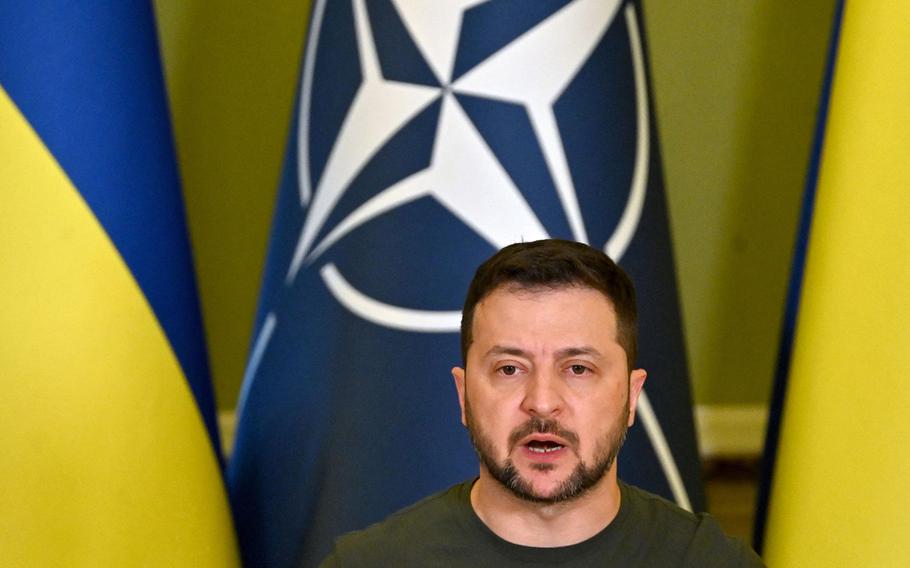Europe
Ukraine steps up strikes on Crimea as offensive grinds on
Bloomberg News September 29, 2023

Ukrainian President Volodymyr Zelensky addresses a press conference with the NATO Secretary General following talks in Kyiv on Sept. 28, 2023. (Sergei Supinsky/AFP via Getty Images/TNS)
(Tribune News Service) — Ukraine has stepped up missile and drone attacks on Russian-occupied Crimea, destroying weapons, bases and supply lines as a four-month-old counteroffensive makes halting progress on the ground in the country’s east and south.
After taking out advanced air-defense systems that had protected the peninsula, Ukraine used cruise missiles and drones to destroy ships and the headquarters of Russia’s Black Sea Fleet and recaptured drilling platforms used for radar activity. As a result, the Russian fleet has been further limited, cutting the Kremlin’s capabilities, according to a European official who requested anonymity to discuss matters that aren’t public.
The operations are part of a broader strategy of targeting Russia’s supply lines, logistics and ability to mount offensive operations, the official said. The intensified attacks underscore Ukraine’s progress in gradually degrading Russia’s military effort — and provide a reminder of the embattled nation’s broader strategic goal of retaking the Black Sea peninsula that Moscow illegally annexed in 2014.
But they aren’t likely to enable Ukraine to make a decisive breakthrough in the ground war this year, said the official.
“For the moment, these processes are in parallel,” said Mykola Bielieskov, a research fellow at the National Institute for Strategic Studies in Kyiv. “Once Crimea as a logistics base becomes vulnerable, the Ukrainians can work more on Russian troops on the mainland.”
The bold moves in Crimea could provide a boost for Ukrainian President Volodymyr Zelenskyy as he labors to keep vital support flowing from Western allies, particularly with growing calls from some Republicans in the U.S. Congress to limit aid and demands from GOP presidential candidates to stop it altogether. During a trip to Washington last week, Zelenskyy warned that Ukraine faces defeat without continued help and vowed to press on with the fighting through autumn and into the winter.
Bielieskov credited the successful attacks on Crimea to Ukraine’s systematic weakening of Russia’s air defenses and new tactics that combine drone and missile strikes to overwhelm what protections remain.
For much of the war, Russia has hinted that striking Crimea would be a red line that might trigger escalation in response. But as Ukraine’s attacks have intensified and had increasing success, those threats have not materialized.
After Kyiv’s missile strikes turned the ornate Sevastopol headquarters of the Black Sea fleet into a smoking hulk this week, the Kremlin limited its reaction to more attacks on Ukrainian cities and efforts to show that the admiral Kyiv claimed to have killed in the attack was in fact alive.
“Nothing happened to us,” the commander of the Black Sea Fleet, Viktor Sokolov, was shown saying in a video posted by Tass news service days after the strike on the headquarters. “The Black Sea Fleet carries out the tasks assigned to it by the command confidently and successfully.”
Attacks on a dry dock damaged a landing ship and a submarine in early September, among other targets.
“The recent strikes on the Black Sea Fleet are another example of how Ukraine retains the initiative,” Admiral Tony Radakin, Chief of the U.K. Defence staff, said on a visit to Kyiv.
Russian naval activity has been “quieter” since the Sevastopol strikes, Ukrainian military spokeswoman Natalia Humenyuk said Wednesday. “The ships are now mainly hiding, trying to find safe places.”
Ukrainian officials suggested at least some of the attacks in Crimea have used the Storm Shadow and Scalp cruise missiles provided by the U.K. and France, some of the longest-range weapons in Ukraine’s current arsenal. Russian air defenses seem incapable of shooting them down, said the European official.
The British and French defense ministers were in Kyiv Thursday to pledge continued support but they haven’t disclosed how many more of the missiles they can provide. Germany has not yet made a final decision on whether to give Ukraine its version of the missiles, know as Taurus.
The U.S. last week said it would finally begin delivering long-range ATACMS missiles that Ukraine has long sought. Allied nations don’t publicly disclose the volume and timing of more sensitive deliveries for security reasons.
Denmark, Norway and the Netherlands have pledged deliveries of F-16 fighter jets in a bid to break Russia’s dominance in air power but they aren’t likely to arrive before the end of this year.
Despite the dramatic strikes on Crimea, allied officials remain skeptical that Ukraine will be able to make a decisive breakthrough in the ground war this year as Kyiv’s forces have struggled to punch through the extensively mined defensive lines Russia has built in the areas it occupies in Ukraine’s east and south.
Ukrainian units this week moved forward near the village of Verbove, with troops pushing toward Russian strongholds further south. The Institute for the Study of War called it a “tactical breakthrough” and said the situation remains fluid.
Ukraine’s forces are “gradually gaining ground,” NATO Secretary General Jens Stoltenberg said on a surprise visit to Kyiv this week. Zelenskyy appealed to the alliance to provide more air defenses as his country prepares for a new wave of Russian strikes on civilian infrastructure this winter.
With assistance from Greg Sullivan
©2023 Bloomberg L.P.
Visit bloomberg.com
Distributed by Tribune Content Agency, LLC.